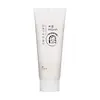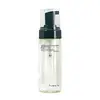What's inside
What's inside
 Key Ingredients
Key Ingredients

 Benefits
Benefits

 Concerns
Concerns

 Ingredients Side-by-side
Ingredients Side-by-side

Oryza Sativa Bran Water
MaskingMyristic Acid
CleansingGlycerin
HumectantWater
Skin ConditioningPotassium Hydroxide
BufferingPalmitic Acid
EmollientStearic Acid
CleansingRice Bran Acid
CleansingLauric Acid
CleansingGlyceryl Stearate
EmollientCocamidopropyl Betaine
CleansingPotassium Cocoyl Glycinate
Dipropylene Glycol
Humectant1,2-Hexanediol
Skin ConditioningOryza Sativa Bran Extract
Skin ConditioningXanthium Strumarium Fruit Extract
Skin ConditioningPortulaca Oleracea Extract
Skin ConditioningAzadirachta Indica Leaf Extract
Skin ConditioningGinkgo Biloba Leaf Extract
Skin ConditioningAvena Sativa Kernel Extract
AbrasiveRhus Semialata Gall Extract
Skin ConditioningAkebia Quinata Extract
Skin ConditioningHydroxypropyl Starch Phosphate
Sodium Polyacrylate
AbsorbentPolyquaternium-7
PEG-100 Stearate
Butylene Glycol
HumectantSodium Chloride
MaskingChlorphenesin
AntimicrobialSodium Benzoate
MaskingDisodium EDTA
Oryza Sativa Bran Water, Myristic Acid, Glycerin, Water, Potassium Hydroxide, Palmitic Acid, Stearic Acid, Rice Bran Acid, Lauric Acid, Glyceryl Stearate, Cocamidopropyl Betaine, Potassium Cocoyl Glycinate, Dipropylene Glycol, 1,2-Hexanediol, Oryza Sativa Bran Extract, Xanthium Strumarium Fruit Extract, Portulaca Oleracea Extract, Azadirachta Indica Leaf Extract, Ginkgo Biloba Leaf Extract, Avena Sativa Kernel Extract, Rhus Semialata Gall Extract, Akebia Quinata Extract, Hydroxypropyl Starch Phosphate, Sodium Polyacrylate, Polyquaternium-7, PEG-100 Stearate, Butylene Glycol, Sodium Chloride, Chlorphenesin, Sodium Benzoate, Disodium EDTA
Water
Skin ConditioningDipropylene Glycol
HumectantDisodium Laureth Sulfosuccinate
CleansingDisodium Cocoyl Glutamate
CleansingCoco-Glucoside
CleansingPolyglyceryl-10 Myristate
Skin ConditioningCamellia Japonica Flower Extract
EmollientCentella Asiatica Extract
CleansingSodium Hyaluronate
HumectantLonicera Japonica Flower Extract
Skin ConditioningMelaleuca Alternifolia Leaf Extract
PerfumingSalvia Officinalis Leaf Extract
CleansingCaprylic/Capric Triglyceride
MaskingCetyl Ethylhexanoate
EmollientEthylhexyl Palmitate
EmollientHydrolyzed Hyaluronic Acid
HumectantHydroxypropyltrimonium Hyaluronate
Sodium Hyaluronate Crosspolymer
HumectantSodium Acetylated Hyaluronate
HumectantMadecassoside
AntioxidantMadecassic Acid
Skin ConditioningAsiaticoside
AntioxidantAsiatic Acid
Skin ConditioningButylene Glycol
HumectantCitric Acid
BufferingCaprylyl Glycol
EmollientHydroxyacetophenone
AntioxidantPentylene Glycol
Skin ConditioningSalix Alba Bark Extract
AstringentPolyquaternium-67
Propanediol
SolventEthylhexylglycerin
Skin ConditioningDisodium EDTA
1,2-Hexanediol
Skin ConditioningWater, Dipropylene Glycol, Disodium Laureth Sulfosuccinate, Disodium Cocoyl Glutamate, Coco-Glucoside, Polyglyceryl-10 Myristate, Camellia Japonica Flower Extract, Centella Asiatica Extract, Sodium Hyaluronate, Lonicera Japonica Flower Extract, Melaleuca Alternifolia Leaf Extract, Salvia Officinalis Leaf Extract, Caprylic/Capric Triglyceride, Cetyl Ethylhexanoate, Ethylhexyl Palmitate, Hydrolyzed Hyaluronic Acid, Hydroxypropyltrimonium Hyaluronate, Sodium Hyaluronate Crosspolymer, Sodium Acetylated Hyaluronate, Madecassoside, Madecassic Acid, Asiaticoside, Asiatic Acid, Butylene Glycol, Citric Acid, Caprylyl Glycol, Hydroxyacetophenone, Pentylene Glycol, Salix Alba Bark Extract, Polyquaternium-67, Propanediol, Ethylhexylglycerin, Disodium EDTA, 1,2-Hexanediol
 Reviews
Reviews

Ingredients Explained
These ingredients are found in both products.
Ingredients higher up in an ingredient list are typically present in a larger amount.
1,2-Hexanediol is a synthetic liquid and another multi-functional powerhouse.
It is a:
- Humectant, drawing moisture into the skin
- Emollient, helping to soften skin
- Solvent, dispersing and stabilizing formulas
- Preservative booster, enhancing the antimicrobial activity of other preservatives
Butylene Glycol (or BG) is used within cosmetic products for a few different reasons:
Overall, Butylene Glycol is a safe and well-rounded ingredient that works well with other ingredients.
Though this ingredient works well with most skin types, some people with sensitive skin may experience a reaction such as allergic rashes, closed comedones, or itchiness.
Learn more about Butylene GlycolDipropylene Glycol is a synthetically created humectant, stabilizer, and solvent.
This ingredient helps:
Dipropylene glycol is technically an alcohol, but it belongs to the glycol family (often considered part of the ‘good’ alcohols). This means it is hydrating and gentle on skin unlike drying solvent alcohols like denatured alcohol.
As a masking agent, Dipropylene Glycol can be used to cover the smell of other ingredients. However, it does not have a scent.
Studies show Dipropylene Glycol is considered safe to use in skincare.
Learn more about Dipropylene GlycolDisodium EDTA plays a role in making products more stable by aiding other preservatives.
It is a chelating agent, meaning it neutralizes metal ions that may be found in a product.
Disodium EDTA is a salt of edetic acid and is found to be safe in cosmetic ingredients.
Learn more about Disodium EDTAWater. It's the most common cosmetic ingredient of all. You'll usually see it at the top of ingredient lists, meaning that it makes up the largest part of the product.
So why is it so popular? Water most often acts as a solvent - this means that it helps dissolve other ingredients into the formulation.
You'll also recognize water as that liquid we all need to stay alive. If you see this, drink a glass of water. Stay hydrated!
Learn more about Water